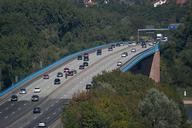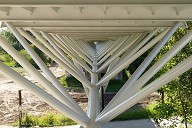Inspection carriage for the Leverkusen Rhine Bridge
The Leverkusen Rhine Bridge was built in the first half of the 1960s. It is 690 m long and constructed as a cable-stayed bridge with two pylons. With a useful width of approximately 37 m, the structure carries the six lanes of the BAB 1 freeway as well as a cycle path and footpath on both sides.
In the meantime, the Leverkusen Rhine Bridge is reaching the limits of its load-bearing capacity and shows considerable damage in all areas. At the end of 2012, the structure had to be closed to vehicles over 3.5 t for three months because cracks were discovered in the girders. After the discovery, it was initially unclear whether the damage to the heavily used bridge structure was at all repairable. Under cover of the closure, the most serious damage was repaired. At several selected locations, "monitor systems" were installed that can detect the smallest changes in the structure. In addition, the structure is under permanent observation by bridge experts. Six lanes have been available again on the Leverkusen Rhine Bridge since May 2013. The speed remains limited to 60 km/h; the bridge remains closed to heavy traffic weighing 44 t or more.
Bridge inspection carriage Rhine bridge Leverkusen
Teupe was awarded the contract for the construction of two bridge inspection cars. The scope of the contract included all work from the preparation of the working drawings in Teupe's technical office to the provision of all verified static proofs including type testing to the manufacture, delivery and assembly of the two bridge inspection carriages. Both inspection carriages can be moved horizontally and vertically along the entire underside of the bridge for carrying out diagnostic and maintenance work.
Design of bridge inspection car
.The bridge inspection carriage travels over rails under the box girder of the bridge. The rails carry the loads of the survey car. These are each introduced into the rails via two trolleys at the top rail and at the bottom rail.
The trolleys for the upper running rail are connected to the traveling platform via a spindle. This compensates for the existing height difference between the lower and upper travel rails.
The systems are electrically controllable and self-sufficient via a power generator installed on each bridge inspection trolley. The lower stage is suspended from four trolleys in the upper stage. Two of these trolleys are moved by a reel chain. The upper transfer table can be moved by hand and locked with a clamping lever. This also applies to the platform on the main stage. The bridge inspection carriages each have four working levels.



 Teupe & Söhne Gerüstbau GmbH
Teupe & Söhne Gerüstbau GmbH




